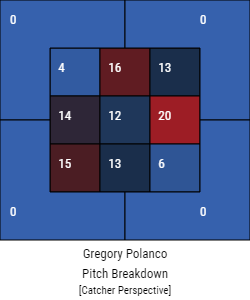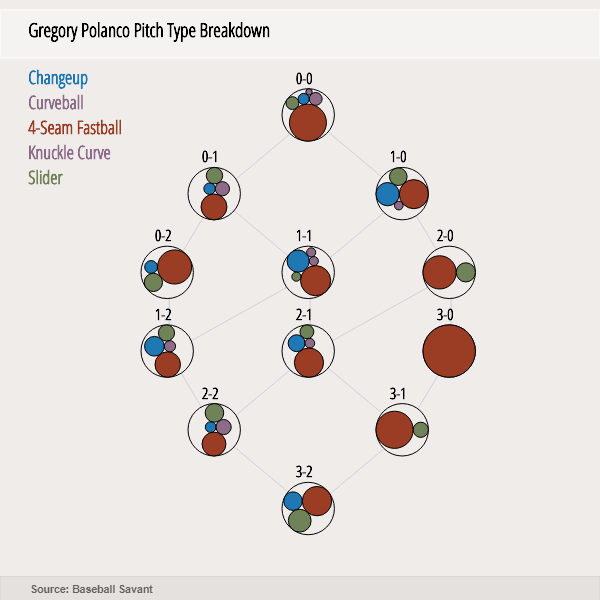Pittsburgh Pirates right-fielder Gregory Polanco has had an up-and-down start to his 2018 season; However there is an easy path to consistency in place for the still-young outfielder.
The Pittsburgh Pirates have invested considerable time and resources into helping Gregory Polanco become the player many envisioned he can be.
Now, in his fifth major season — and fourth full season — Polanco has settled in to something else: a productive enough player when he is at his best. Of course, he can also serve as a black hole in the lineup when his worst tendencies take center stage.
As we stand today, Polanco has put up a respectable .741 OPS. He carries six home runs on the year and eight doubles. So, yeah, Respectable. However, there is a clear path to better production and more consistency for Polanco and, as it happens, it is an easy one.
Recognize the pitch to hit
It might surprise you to hear that Polanco carries a .388 xwOBA (expected weighted on base average) against fastballs in 2018. His actual wOBA on heaters comes in at .332, showing a bit of bad luck.
It may also surprise you that Polanco, long known as one of the more free swinging Pittsburgh Pirates, carries a 22.7 percent whiff rate on fastballs in 2018. While not an elite Joey Votto-esque elite number — Votto is whiffing on just 17.4 percent of his fastballs seen — it’s certainly an encouraging figure.
Among Pittsburgh Pirates hitters with at least 50 fastballs seen, Polanco sees the fourth most fastballs — 60.3 percent of his pitches seen — trailing Corey Dickerson (61.08 percent), Adam Frazier (63.43 percent) and Francisco Cervelli (64.98 percent).
So, Polanco is seeing his fair share of fastballs. And hittable ones at that. Of the 249 total pitches Polanco has seen in the strike zone this season, 71.4 percent are fastballs.
So why, then, is Polanco’s zone contract rate limping in at 28.1 percent?
We’ve hit you with a lot of stats. Let’s put it all into a table to summarize:
| Total Fastballs Seen | 249 |
| Fastballs in zone | 179 (71.4%) |
| Contact rate on in-zone fastballs | 27.9 % |
| In zone Four-seamers | 113 (63.5%) |
| In zone Two-seamers | 42 (23.6%) |
| In zone Sliders/Cutters | 27 (12.9%) |
It can be perplexing to figure out why exactly Polanco cannot connect on more of these fastballs in the zone.
Our pal Alex Stumpf talked a lot about some perceived holes in his swing over at The Point Of Pittsburgh. Do check out that article when you have a moment, but here we will focus on the four-seam fastball, which make up the bulk of Polanco’s fastballs seen in the zone, If we limit our look to the pure heat, the distribution seems to be somewhat even:
Polanco’s average exit velocity on four-seamers in the zone clocks at 89.8 percent. Only three of the 25 four seamers he has connected on in the zone are considered “barrels” by Statcast.
Why is it that a hitter of Polanco’s raw talent has trouble connecting on these fastballs? The eye is drawn to the one outlier on the graph above – middle-inside, where Polanco has seen 20 four-seams, having made contact on just three.
As Alex noted, Polanco has long since had a greater hole in his swing the further a pitch comes in on him, so we can almost just throw that part of the zone map out. What about the other zones? Polanco is getting his fair share of four-seamers to hit in other locales, so why can’t he do more with them?
The answer might lie in when those pitches come.
Hunt and Swing
Let’s look at Polanco’s pitches seen by count. For simplification, this chart shows only four-seam fastballs against breaking/offspeed pitches:
(Note: though two-seamers, cutters and sinkers were left out of this chart, I can anecdotally tell you that the four-seam still dominated the chart in nearly all counts.)
Here we can see that not only is Polanco seeing fastballs in obvious fastball counts, but he is also seeing them in less than ideal times for a pitcher to offer one up.
If we look at in-zone four-seam data on 0-0, 1-0, and 0-1 counts, we find that Polanco has seen 54 four-seam fastballs in these counts, of which he swung at 25 of them, making contact 10 times. That’s a swing rate of 46.2 percent, and a contact rate of 18.5 percent.
If we compare this in-zone four-seam data to MLB as a whole, we find that Major League Baseball carries a swing rate of 53.4 percent in these same counts, making contact at a 19.7 percent clip.
Polanco is swinging a significant amount less at four-seam fastballs early, which pitchers are offering up to the 26 year-old. The difference in contact rate is minimal, but significant when taken over an entire season.
If Polanco can hunt fastballs early in the count, he might just be able to do the amount of damage befitting the second spot in the order, where Pittsburgh Pirates manager Clint Hurdle is determined to keep him.
Add The Sports Daily to your Google News Feed!









